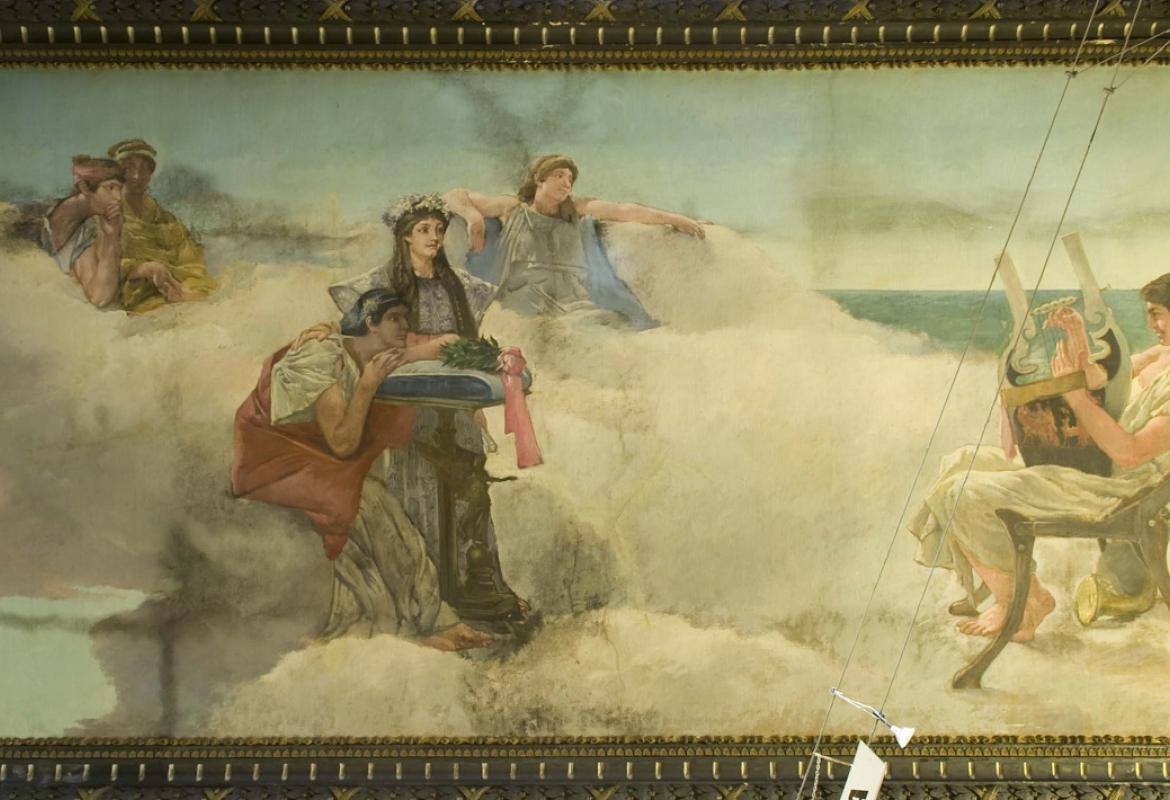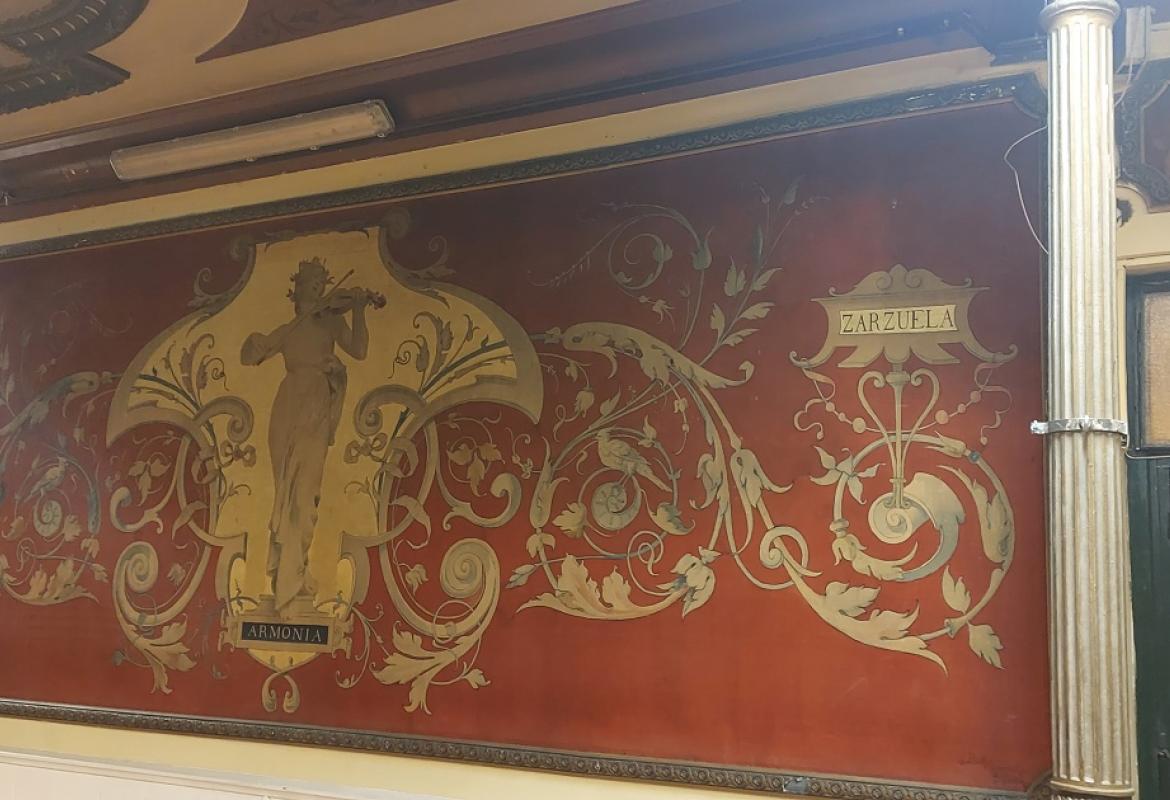

Montano Building
Asset of Heritage Interest in the Monument category
The Montano building and the old piano factory attached to it form a complex of special historical and artistic significance. The building was built between 1884 and 1890 by the architect Ricardo Montano, constituting a notable example of Madrid domestic architecture of the XNUMXth century, in a simple and austere line, fundamentally highlighting the mural decoration of the music room located on the ground floor, the only preserved work. by the brothers Daniel and Germán Zuloaga, which maintains an entire decorative program alluding to music.
In the Montano music hall, recitals by outstanding performers were held, becoming one of the most important audition rooms of the time, a privileged setting in Madrid's musical history and the only audition room that remains of the numerous existing ones in Madrid between the last decades of the 19th century and the first of the 20th.
Origin of the piano factory and Montano building
Around 1840, Alfonso Vicente Montano from Madrid founded the Montano Piano Factory, beginning its activity as a small workshop. In 1885 it was expanded with the construction of a residential building where the Montano music hall would be located.
From its beginning, this family business, which its seven children would continue until the mid-30s, was mainly dedicated to the manufacture of pianos and harmoniums, later expanding to include other instruments related to mechanical music, such as player pianos, autopianos and electric pianos, as well as the distribution of instruments from other brands.
The press of the time highlighted the quality of Montano pianos, highlighting that they could compete and even surpass foreign ones. Among other decorations, they received a bronze medal at the Universal Exhibition in Paris, for their manufacturing and uniformity of sound, as well as two distinctions for the innovation known as the "Montano System", which allowed the internal mechanism of the instrument to be observed through a glass. .
In 1883, the architect Ricardo Montano proposed a project for a residential building attached to the factory, preserved in the Archive of the City of Madrid, which would house on its ground floor rooms for the exhibition and sale of instruments, as well as a concert hall, in the style of the French piano company Pleyel.
Inaugurated in 1890 with wide coverage in the local press, in addition to the concerts organized by the Casa Montano as part of its commercial activity, the hall hosted private and charity concerts, multiplying its activity from 1913 when it was rented by the newly created Society of Friends of Music.
Musicians such as the young cellist Pau Casals or the guitarists Daniel Fortea and Luis Soria Iribarne passed through the room, but also teachers and students from the conservatory.
It was considered one of the most outstanding among those existing in Madrid at the end of the 19th century, along with others such as the Salón Zozaya, the Salón Romero or, at the beginning of the 20th century, the Sala Gasset y Toledo, the Sala Navas or the Campos Room.
It remained operational until 1930, although its activity progressively declined at the same time as the factory. The spread of the gramophone and phonograph also influenced the decline of spaces like this one, dedicated to in-person musical practice.
The Montano building: Asset of Heritage Interest
The building has two facades facing San Bernardino and Dos Amigos streets, with brickwork and the corners simulating chains of ashlars. The panels are decorated with plaster tondos that enclose the letter "M" and the façade ends in a chamfer with a medallion in relief with the portrait of Vicente Montano and the inscription "MONTANO".
The most notable part of the building is the decoration of the music and exhibition hall, located on the ground floor. It is a large rectangular room divided by a line of cast iron columns, fully decorated with paintings on its ceilings and walls. The columns, with fluted shafts and capitals with vegetal decoration, preserve their original polychrome.
La wall decoration that covers walls and ceilings is the work of Zuloaga brothers, Daniel (1852-1921) and Germán (1855-1886), ceramists and painters of recognized prestige. Eclectic in style, with Renaissance, Baroque, historicist and symbolist motifs, it is made in two techniques: using thick fabrics simulating tapestries or on thin canvases painted in oil, a technique also used on the ceilings, all of them framed by plaster moldings.
The panels between each opening of the room are decorated with portraits of famous composers
like Beethoven or Albéniz. The interior wall is decorated with two allegories alluding to the Composition: and Harmony, represented as two female figures carrying a pen and paper and a violin, respectively, with the inscriptions “ÓPERA” and “ZARZUELA”.
The two ceiling compositions represent the allegory of the Music in Antiquity, inspired by Sappho and Alcaeus by the painter Sir Lawrence Alma-Tadema (1881) and to Music in the Baroque, reproducing the Frederick the Great's flute concert in Sanssouci, by the German painter Adolf Menzel (1850-1852). At the ends, angels carrying symbolic elements related to the Geometry, Stores, the Spring Suspension and Telephone as well as the scene of Jupiter and Io, reproduction of a painting by Correggio.
To know more >>> Download ORDER 20/2024, of January 16, of the Minister of Culture, Tourism and Sports.











